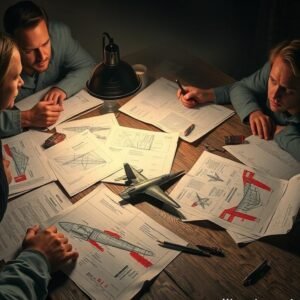Universe 25: An Islamic Perspective on Societal Collapse.

Universe 25: Islamic View of Societal Collapse
Could absolute abundance become detrimental? What if a paradise for mice devolved into a hell of despair? This episode delves into the Universe 25 experiment from an Islamic perspective, exploring how human free will and societal responsibility can culminate in either a utopia or a dystopia, as envisioned by Islamic thought. We will examine the depths of this unsettling experiment, analyzing its potential as a dark prophecy for our future, and posing the critical question: are we destined to repeat the fate of the mice of Universe 25?
Before we explore the compelling evidence, please share your initial thoughts in the comments section. To ensure you don’t miss any part of our insightful exploration, subscribe to the channel.
John B. Calhoun: The Architect of Mouse Utopia
As we await the unveiling of the answers, let’s highlight the innovative mind behind this controversial experiment: John B. Calhoun. Born in 1917, Calhoun was an animal behaviorist and behavioral ecologist who dedicated his career to exploring the complex relationship between populations and their environment.
The Behavioral Sink: A Precursor to Universe 25
Prior to the Universe 25 experiment, Calhoun was already studying the impact of population density on mice, a pursuit he began in the 1940s. At the Brookville farm in Maryland, he observed a perplexing phenomenon: even with unlimited resources, the mice ceased reproducing once their population reached a certain threshold. This critical observation led him to formulate the concept of the behavioral sink, a term describing a range of abnormal and destructive behaviors that emerge under conditions of overpopulation.
Inspired by French sociologist Émile Durkheim, who studied the impact of social changes on suicide rates, Calhoun saw parallels between the behavior of mice in crowded environments and the social problems facing major cities. In 1968, Calhoun articulated his vision in an influential essay titled “Death Squared: The Explosive Growth and Demise of a Mouse Population,” where he presented his reflections on the future of humanity based on his experiments on mice. Was Calhoun observing in the behavior of mice a grim premonition of what awaits us?
Universe 25: A Paradise Lost?
In 1968, at the National Institute of Mental Health, the Universe 25 experiment was initiated. It was not merely a cage, but a meticulously designed miniature world intended to simulate a utopia. A vast space, resembling a sprawling city for its inhabitants, was completely free from the harsh realities of nature. There were no predators and no diseases. Hundreds of dwelling places, each a miniature architectural marvel, were strategically placed to meet the specific needs of the mice.
Imagine a world where a mouse knows neither hunger nor thirst. Food and water dispensers were ubiquitous, ensuring constant abundance. A sterile environment protected them from disease. Only four breeding pairs, the foundation of a new society, were introduced into this paradise. The objective was to understand the profound impact of population density on the complex social structure. But could paradise transform into a living hell? Could an excess of blessings ultimately lead to ruin? Calhoun, through this experiment, sought to find answers not only for mice, but for all of humanity.
The Golden Age: A False Dawn
Initially, everything progressed ideally. An abundance of food, water, and nesting materials fostered comfort. There was no fear of predators or disease. The population doubled at an astonishing rate, every 55 days. Nests were built, offspring thrived, and a flourishing society pulsed with life. The mortality rate was negligible, reflecting the ideal conditions. Calhoun termed this phase the “Strive for Death,” but it was, in reality, a golden age. A period of prosperity unprecedented in mouse society. A period of bright hope, before the tides turned and everything was upended.
The Behavioral Sink: The Descent into Chaos
Following that golden period, when the population peaked on day 315, and paradise was saturated with 2200 mice, a deep fissure began to emerge. It was no longer simply abundance and prosperity, but a harbinger of the beginning of the end. Here, the concept of the behavioral sink, coined by Calhoun, materialized, describing the abnormal and destructive behaviors that began to surface. Overcrowding was not just a number, but a catalyst for chaos. The males, previously protectors, became aggressive. They attacked the young, assaulted the females, and formed gangs that spread terror. The females faced something worse. Abortion rates rose, interest in the young diminished, and infant mortality rates increased. Mothers abandoned their offspring to an unknown fate in this deceptive paradise. The traditional social hierarchy collapsed. There was no respect for elders, no regard for rules, only chaos.
The Beautiful Ones: An Embodiment of Hopelessness
Amid this collapse, a disturbing category emerged, called the “Beautiful Ones.” Male mice abandoned their roles, as if they had lost their purpose. They did not mate, defend territory, or show interest in anything other than their silence. They relinquished their role in this chaotic society, as if they were disembodied spirits. As for the females, they faced an even more dire fate. Abortion rates rose, snatching life before it began. Interest in the young diminished, turning into indifference, and infant mortality rates increased. Mothers abandoned their offspring to an unknown fate in this deceptive paradise, as if mercy had been wrenched from their hearts. The traditional social hierarchy collapsed, leaving a void. There was no respect for elders, no regard for rules, only chaos. Then these Beautiful Ones appeared, with their clean fur, free from scars, as if they lived in a parallel world, separate from this torment. They did not participate in conflict, did not defend themselves, but isolated themselves in silence, as if they were witnesses to the end of the world. In contrast, primal instincts flared, revealing the ugliest aspects of the soul. Incidents of cannibalizing young mice increased, shocking even the most hardened hearts. Maternal bonds disintegrated, replaced by brutality.
The Beautiful Ones were an embodiment of hopelessness, a reflection of a miserable reality, a bleak picture painted with helplessness. By day 600, everything stopped, as if life had surrendered. The sound of life ceased, and reproduction, the source of existence, stopped. There were no new births, only silence hanging over the place like a mourning robe, a silence that devoured light. The society that had been teeming with life, which had witnessed joys and sorrows, turned into a barren desert, where only sad memories sprouted. The mothers who had protected their young became cannibals, in a scene that breaks hearts, and leaves a scar on the soul. This was not just physical hunger, but despair that had settled in the souls, a loss of feeling for everything beautiful, and a loss of the maternal instinct. Not only did the mouse die, but hope itself died with it.
An Islamic Perspective: Are We Destined to Repeat History?
Today, we humans stand on the edge of a similar precipice, a question echoing: are we walking the same tragic path? By 2050, the world’s population is expected to reach 9.7 billion, placing pressure on our scarce resources. “Eat and drink, but do not waste. Indeed, He does not like those who waste,” a divine warning from Surah Al-A’raf, but will anyone heed it? Statistics indicate that one in nine people suffers from undernourishment, while a third of the food produced globally is wasted. Where is the justice in this distribution? The global Gini coefficient, the indicator of income inequality, continues to rise, indicating the widening gap between a minority and a majority that suffers. Does this not remind us of the fate of the outcasts in the Universe 25 experiment, who were swallowed by marginalization? Social isolation, as revealed by a study from Harvard University, increases the risk of premature death by 29%. Our souls groan in silence, while we pretend to connect through screens. Trust in institutions is eroding, and values are fading. Global carbon dioxide emissions exceeded 40 billion metric tons in 2023, exacerbating the climate crisis. Is this not the behavioral waste that Calhoun talked about, a self-destructive behavior that is leading us towards the abyss?
Where are we today from the teachings of our religion, which calls us to balance and moderation, and reminds us that we are accountable for our actions? The experiment witnessed by Universe 25 brings to mind the verse of the Great Trust: “Indeed, We offered the Trust to the heavens and the earth and the mountains, and they declined to bear it and feared it; but man [undertook to] bear it. Indeed, he was unjust and ignorant.” We have borne the responsibility of free choice, but the question is: are we up to this responsibility? At the heart of Islam, we find the Fitra, that internal compass that is supposed to guide us towards good, but it is not an absolute guarantee. Surah Al-Balad reminds us that God has guided us to the two paths, the path of good and the path of evil, leaving the test subject to our will. And the story of Cain and








